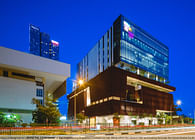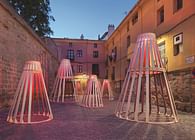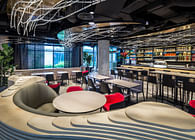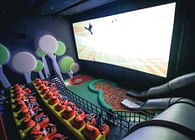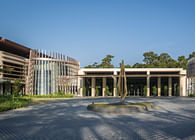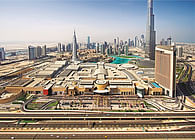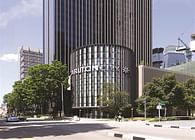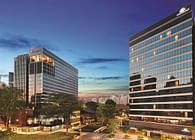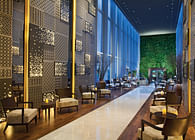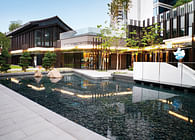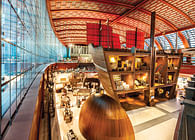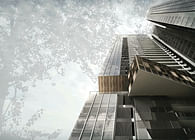
Singapore, SG
The Dubai Mall is a retail project that defies categorisation due to its massive scale and complexity. It is not just a piece of architecture; it is a construction in a space of vast scale, and it possesses the complexity of an urban centre.
Measured by covered area, it is the largest mall in the world. Yet breaking the record to build the largest mall was not the goal for DP Architects. Instead, the important principle throughout has been to develop a piece of architecture that will continue to be enjoyed by the entire family while giving retailers the most efficient and functional working environment. Catering to both the visitor and the retailer has created the best shopping experience in the world.
Addressing the needs of such a large-scale retail project, DP Architects adopted a city design process and rethought every aspect of retail architecture design.
An emerging international city, Dubai has gained global attention, in part, because of its ambitious architectural projects that challenged the norms in terms of scale or audacity. The world’s largest covered mall, The Dubai Mall, is adjacent to the world’s tallest building, Burj Khalifa. Despite the mall’s scale and context among the biggest and the best, it was first and foremost designed as a supremely functional space.
Combining many years of experience in retail design, DP Architects conceived five planning principles: clear pedestrian circulation with no secondary corridors or hidden corners, visual connectivity to all shopfronts, sufficient parking space and integrated public transportation, efficient service areas for each tenant, and subdivision of the mall into zones with distinct characters.
DP Architects didn’t consider The Dubai Mall just a shopping centre in itself, but a micro-urbanism manifested by the interactions among its habitats and visitors. The scale of the project and the need to differentiate districts for wayfinding and to create attractions necessitated the incorporation of elements of urban planning. In this way, a singular piece of architecture can demonstrate the quality of a miniature city.
There are three primary planning conditions that were applied to the ‘urban design’ of The Dubai Mall. The first is that the circulation and retail spaces need to have clarity and legibility. This aspect is of special importance when navigating in environments at the urban scale. To be lost in an immense setting that has over 23 linear kilometres of pathways would be a frustrating experience and would guarantee visitors’ hesitation to return.
A quadrant circulation pattern with recognisable nodes was created for legibility. Nodes for rest and relaxation were choreographed in key locations along the walkways; these public spaces effectively created landmarks that aid in wayfinding and create attraction points that offer variety to the urban experience. Like any meaningful and rich urban setting, each node has something special and is given a specific name and theme. The scale of each node was considered in direct relation with the visitor’s journey.
Similarly, retailers can easily be seen from a visitor’s perspective so that when you are in an atrium space you can see the retailers on other floors. This visual connectivity allows for recognition and familiarity. Just as a miniature city, The Dubai Mall has its intimate inner pattern: the street, square and other attractions that make it liveable.
A second aspect of the mall’s urban condition is its extremely rich and diverse collection of public spaces and mixed programmes. Due to its unprecedented scale and an edict by the client to ensure that the mall offers something for the whole family, the architects had the opportunity to investigate a variety of non-commercial programmes beyond the retail focus.
The design team perceived urbanity as a set of relationships, both physical and social. The Dubai Mall brings together an incredibly diverse assortment of visitors from around the world. Thus, the designers attempted to encourage the mixing of the various demographics by creating urban conditions for various social events and occasions.
The mall incorporates multiple large-scale attractions normally only seen in the city ¬– one of the world’s largest indoor aquariums, an indoor triple-height waterfall, an indoor adventure park and an Olympic-sized ice-skating rink. Along with these attractions are multiple and unique atrium spaces that perforate the boulevards as social collectors, and respite points that use materiality and the play of natural light to create unique environments along the mall’s boulevards.
Due to its location at the physical centre of the mall’s primary axis, the forecourt of the Dubai Aquarium and Underwater Zoo functions as a public plaza for gathering and features one of the largest acrylic viewing panels in the world. These numerous vivid integrated settings cater to multiple public activities on many levels at all times of the day, serving as a civic destination for families.
Beyond practical functions, these public settings and attractions are highly valuable as they create collection points for potential shoppers. The enormous mass of The Dubai Mall has been perforated by well-formed public spaces adjacent to shopping areas.
The last aspect that embraces the notion of micro-urbanism is its circulation system which has been planned to accommodate vehicle movement and linkages for this miniature city. One thousand and two hundred shops and parking for 14,000 vehicles are supported by a network of roadways. The building is accessible through four grand entrances and vehicular drop-off points, which are transition points to enter the building. These entrance pavilions operate at the scale of the car and the building through their expressive and identifiable volumes, as well as at the human scale with their detailed mashrabiya surfacing treatments and finishes.
The elongated Grand Drive was conceived as a form of ‘architectural promenade’ to enhance the sense of arrival and create a showplace to see and be seen. Within the many levels of parking decks, 53 entrances were named after its respective nearby landmarks, such as ‘Gold Souk Entrance’ or ‘Ice-rink Car Park’. These cues of orientation and path-finding are part of an overall identifiable network.
Just as important, retailers have dedicated, extensive loading areas with a network of behind-the-scene corridors that allow seamless operation of the shopping mall, ensuring that goods can be brought in as efficiently as possible. While efficient and logical circulation may not be the first thing that people think of when considering the top aspects of spaces, it is with repeat usage that the skills of the design team become apparent – the team has designed a mall that lends itself to repeat customers.
The Dubai Mall has charted a new way to conceive a large-scale built environment as a micro-urbanism, and it has become a new form of retail paradigm that has invigorated the global retail scene. While it would be obvious to only dwell on the more obvious conditions of the mall’s design, such as the considered design of its roofscape or the delicate selection of materiality – the true heart of the mall’s success lies in the effective planning techniques. It is supremely functional which has led to its continued success of breaking visitor targets every year since opening.
World’s Biggest Mall Gets bigger
The Dubai Mall not only has been an influential civic focal point in Downtown Dubai since its opening in 2008, but has also become one of the world's most popular shopping and leisure destinations. All kinds of activities and events bring vivid social life inside. The mall has proven to be incredibly successful and the number of visitors has risen steadily every year.
In 2012, the mall welcomed 65 million visitors – attracting more tourists than New York City – far exceeding the initial annual projection of 35 million.
To prepare for a projected 100 million visitors, another one million square feet (92,900sqm) is being added to The Dubai Mall in the first phase of a massive expansion.
The popular Fashion Avenue will be developed further to accommodate new and personalised flagship stores of the world’s top brands, enhancing the fashion portfolio of the mall.
Expected to open by December 2015, this expansion will further enhance the lively urban experience and create more distinctive public spaces within The Dubai Mall.
Status: Built
Location: Dubai, AE
